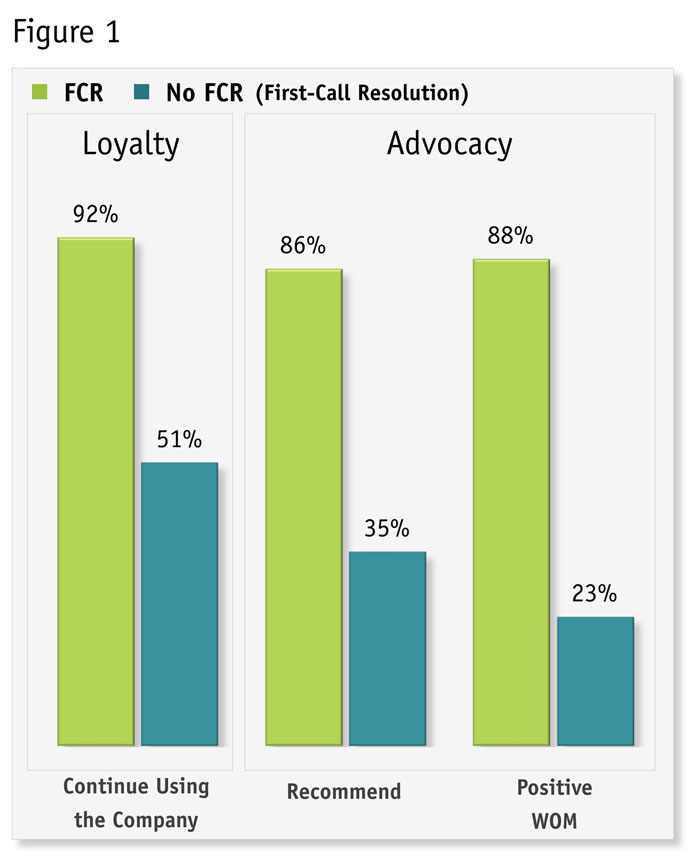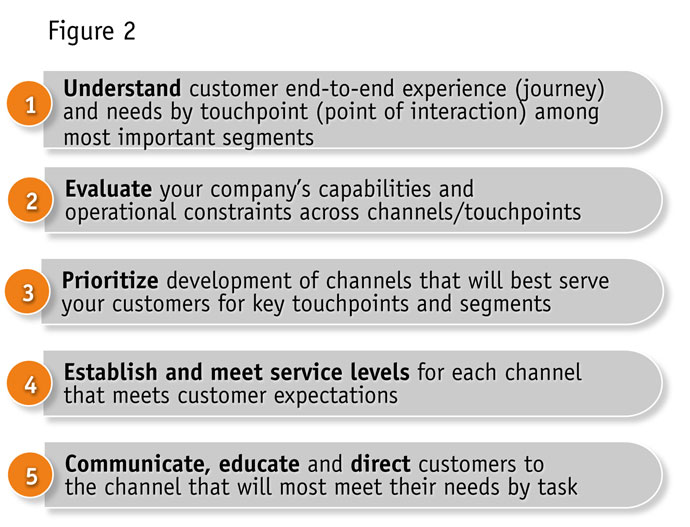Editor's note: Cynthia J. Grimm is vice president at CX Act, an Arlington, Va., customer experience consulting firm.
While contact channels abound and companies tout their omnichannel service, research conducted by our firm, CX Act, with both customers and companies finds that companies are not as “omni” as they think they are – and customers don’t really care.
This “everything to everyone” approach does not really drive higher customer satisfaction and loyalty and, in fact, could be leading to decreases of both. While there are good financial reasons for a company to provide omnichannel service, implementing this service in a way that doesn’t meet customers’ needs does far more harm than good.
A more rational approach lies in focusing on the end-to-end customer experience and tasks across that experience, optimizing contact channels (single- or omnichannel) that will best meet that need and then steering the customer to the best solution.
At the end of the day, customers want their customer service question or complaint resolved quickly and easily in the first contact. Our research shows that customers who receive a first-contact resolution (FCR) during their customer care interactions, regardless of channel of contact, are nearly twice as likely to remain loyal and four times more likely to spread positive word of mouth about a company (Figure 1).

Increased FCR also has a direct impact on reducing company handling costs, so anything a company can do to increase the likelihood of first-contact resolution goes straight to the bottom line.
The majority of company respondents to the CX Act research (more than 60 percent) said their company is not capable of handling customer issues in one contact via non-telephone channels – such as self-service, e-mail, live chat, social media and mobile. Most inquiries through these channels involve at least a second contact, in which the customer is sent to the (more expensive for the company) telephone channel for resolution.
Customers seem to know this, as less than 60 percent said they expect their issue to be resolved in one contact when contacting via self-service, mobile or social media. Companies and customers also agree that telephone (also the most mature of the contact channels) is the one channel with a high confidence of resolution in one contact.
Our research shows that 75 percent of customers use traditional contact channels (primarily telephone) as the first channel of contact when they have a question, complaint or to conduct a routine service transaction, with little difference by age. While younger customers may be more willing to try alternative channels, they tend to hold back when contacting with questions and complaints, with the expectation that traditional channels are more likely to result in quick resolution.
When employees were asked if their company makes it easy to handle customers’ issues via various channels, and customers were asked about their expectations for each channel’s ease of use, telephone was the only channel cited as meeting or exceeding customer expectations. Channels with the greatest opportunity (largest considered future use and lowest performance) were mobile, self-service on Web and e-mail.
A channel of choice
So, what channels do customers want? While traditional care (especially phone) will continue to be a channel of choice, when asked which channels they will consider using in the future, three times more said they would consider self-service online and 10 times more said they would consider using a mobile channel, with younger customers more likely than older customers to consider using non-telephone channels.
Customers tend to make their choice of channel based on the perception of which channel will best meet their needs for a specific task. Research by the Corporate Executive Board1 found that most customers (84 percent) are “ends-focused” (focused on satisfactory resolution of their issue, regardless of channel used) and only 16 percent are “means-focused” (wedded to a certain channel of preference, regardless of their sense of its fitness to the task).
Our research puts a finer point on this, showing that the most important factors driving customer selection of a given contact channel are:
- First, the degree to which they believe accessing the channel will be “quick and easy.”
- Second, their level of expectation that, in this channel, their question/complaint/transaction will be resolved in the first contact.
- Third, when the reason for contact is a complaint or a question, customers desire “human contact.”
If the reason for contact involves a sensitive (e.g., billing-related) transaction, customers value “security” more and tend to gravitate toward a self-service-on-the-Web channel.
The lesson here is that customers do not care about the extent of a company’s “omni-ness.” They care about the quality of service. More to the point, it’s better not to be in a channel at all if you’re going to do it badly.
Two essentials
Returning to the key elements of what makes a great interaction, it all comes down to two essentials: first-contact resolution and making it quick and easy for the customer. Our data goes one level deeper to identify three key drivers of FCR and what “quick and easy” means: personal details available; previous interactions available; and personalized solutions.
When the interaction is via telephone, a fourth key driver enters the picture: “warm and friendly experience.”
These key drivers can create a perception of “quick and easy” even when crossing channels. For example, in a recent interaction with a major airline, the author attempted to make a reservation online and then called the airline. The automated system recognized me from my phone number, verified my identity and then said “Are you calling about the reservation you were attempting to make today online to Omaha?” This seamless integration of personal information and knowledge of interactions in another channel dramatically increased the ease of getting my issue resolved and had a feel of being one continuous contact.
Not easy
Of course, the actual implementation of this level of integration is not easy, given the myriad legacy and siloed systems that most organizations operate. In fact, “technology constraints” and “more pressing priorities” were the two biggest barriers to omnichannel customer care that companies reported in surveys.
Companies face the ultimate challenge of when and how to shift both emphasis and dollars from high-cost/high-value channels (such as telephone) to lower-cost, non-traditional channels in the face of failed or stalled attempts and customer reluctance to trust the new channels to meet their needs. While omnichannel customer service holds great promise for cost reduction, current attempts to be “everything, all the time, everywhere” often result in duplication of costs rather than achieving operational efficiency.
So, how can companies achieve the balance between offering new channels and meeting customer expectations? The answer is focus – focus on understanding the customer’s end-to-end experience and needs, focus on understanding company capabilities, focus and prioritize channel development and focus customers toward the channels that will most meet their needs for the specific reason for contact.
The suggested methodology, pictured in Figure 2, provides a guide for companies to optimize their omnichannel customer care experience.

It begins with an “outside-in” understanding of the end-to-end customer journey and key touch-points/interactions of the most important customer segments. This often starts with an internal cross-functional group outlining a customer journey map but needs to be supported by robust customer research to validate and quantify the key moments of truth and the points of pain.
The second step is to evaluate the company’s capabilities to meet customer expectations for the touchpoints that are moments of truth through the various channels and assess the challenges and barriers to meeting those expectations.
The third step is the most important and maybe the hardest. This is where difficult decisions need to be made on what channels should be offered and how they will be developed, supported and integrated.
Critically, not all channels are appropriate and it is better for a company to decide not to offer a channel than to do a poor job of delivering within that channel. For example, Netflix is a company that has taken a more focused approach. It has decided that it cannot adequately provide a quick and easy resolution on first contact via e-mail, so it does not offer e-mail as a channel. Instead, it has developed a robust self-service help center online, with easy access to a live person via either chat or phone. The help page transparently displays the current availability and wait time for chat and phone, so that the customer can choose the faster of the two if they have no preference otherwise. It also generates a code that is entered prior to being connected to the customer service agent, so that Netflix will be able to easily access the customer’s personal information for a seamless one-contact resolution.
The data collected in steps one and two allow the company to quantify the economic impact of not meeting customer expectations, versus the cost of developing alternative channels or channel integration.
The fourth step, establishing and meeting service levels, is all about making sure any channel offered delivers on the promise of good service.
The fifth and final step is communicating with customers to educate them on the most appropriate channel, by task, to meet their needs. For example, simple questions can often be easily and quickly resolved with self-service, supplemented with the possibility of a chat agent. For complaints, it is better to immediately get the customer to a live agent for a quick resolution with a human touch.
Exact opposite
Simply put, trying to be all things to all customers may seem like a customer-focused approach but for most companies it is the exact opposite. The best way to meet customer needs is to resolve customer questions, complaints and transactions quickly, easily and in one contact (or what feels like one contact).
That doesn’t mean omnichannel should be ignored. It is something customers, especially younger ones, value, as long as they can successfully gain resolution. And the key word here is “successfully.” Moving some interactions away from the more expensive telephone channel to less-costly alternative channels can benefit the company’s bottom line – again, as long as interactions are “successfully” handled in the first contact.
The key to all of this is to adopt a focused and systematic process that incorporates the customer’s view across the end-to-end experience and a realistic assessment of corporate priorities. This five-step process is a good starting point to achieve success.
REFERENCES
1 “Rethinking multichannel strategy,” Corporate Executive Board, April 2013.
